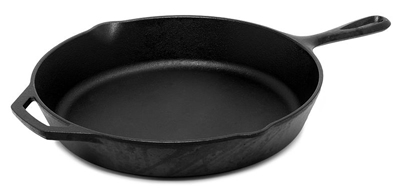 Scrubbing pots and pans is an annoying chore. If you’re like many people, you’ve been using non-stick cookware to make your life a little easier. Did you know you could be exposing yourself to dangerous toxins? Non-stick pans use a chemical called Polytetrafluoroethylene (PTFE), also known as Teflon, to keep food from sticking. Teflon releases dangerous fumes into the air when heated. These fumes, which are released after just five minutes of cooking, can cause you to develop a flu-like condition called “Teflon flu.”
Scrubbing pots and pans is an annoying chore. If you’re like many people, you’ve been using non-stick cookware to make your life a little easier. Did you know you could be exposing yourself to dangerous toxins? Non-stick pans use a chemical called Polytetrafluoroethylene (PTFE), also known as Teflon, to keep food from sticking. Teflon releases dangerous fumes into the air when heated. These fumes, which are released after just five minutes of cooking, can cause you to develop a flu-like condition called “Teflon flu.”
Perfluorooctanoic acid (PFOA), sometimes called C8, is another toxic chemical found in non-stick cookware. It’s used to attach Teflon to the insides of your pans and pots. Research shows that PFOA could raise cholesterol levels, contribute to thyroid disease and affect fertility.
In the 1990s, the Environmental Protection Agency discovered that many people have PFOA in their blood. It’s not clear where this PFOA is coming from, as it’s used in many products besides cookware, such as fire-resistant cables and tubing, textiles and carpets. PFOA is extremely hard to avoid altogether; getting rid of it in your cookware is a good first step.
Quiz: Is Your Body TOXIC? Take the Test...
(get your free personalized report)
How to keep food from sticking without using non-stick cookware
1. Use seasoned cast iron
Cast iron cookware withstands higher temperatures than Teflon cookware – even temperatures high enough to brown meat. It can be placed safely in a very hot oven. It lasts for many years, so while it might be expensive to purchase, it will save you money in the end.
By seasoning your cast iron cookware, you’ll prevent food from sticking to it. To season, preheat your oven to 325 degrees Fahrenheit. Wash your cookware with warm, soapy water, then dry. Apply a small coat of oil to the inside and outside, then bake for an hour.
Seasoning your pan won’t just prevent sticking. It will keep the iron in the pan from reacting to acidic foods, such as tomato sauce, and affecting the taste.
2. Cook with stainless steel
Quiz: Is Your Body TOXIC? Take the Test...
(personalized report)
Pots and pans made of stainless steel are also great for browning. To keep food from sticking, make sure to add oil before cooking.
3. Consider ceramic
A ceramic coating on cookware will prevent food from sticking somewhat, although you’ll still need a little bit of oil. Because ceramic is non-reactive, you won’t have to worry about chemicals getting into your food when you cook at high heat.
About Teflon-Free Non-Stick Cookware
Some manufacturers now make non-stick pots and pans that don’t contain Teflon or PFOA. Instead, they use new chemicals, such as Thermolon, to prevent sticking. These new non-stick substances haven’t undergone much independent scientific testing. It’s best to avoid them until it’s certain they’re not harmful.
Isn’t Oil Bad?
Unfortunately, cooking with oil has gained a bad reputation over the years, as the result of a mistaken belief that all fats and oils are bad for you. In fact, fats and oils are an essential part of a healthy diet.
The trick is to choose oils with added health benefits. Olive oil and sesame oil, for example, reduce inflammation. Flaxseed oil contains healthy Omega-3 fatty acids, which are important for heart health. For a change, you can try stir-frying with coconut oil, which can boost your immune system and help stabilize your blood sugar.
If You Have to Use Teflon
If you must use non-stick cookware, cook at the lowest temperature that is safe, and use an exhaust fan to keep fumes out of your kitchen. Never put your cookware in an oven heated to more than 500 degrees Fahrenheit.
Fumes from non-stick cookware are deadly to birds, so if you have a pet bird, keep it far from the kitchen when you’re cooking.
Additional Sources:
Perfluorooctanoic Acid (PFOA) and Fluorinated Telomers, Environmental Protection Agency
Skip the non-stick to avoid the dangers of Teflon, Environmental Working Group
